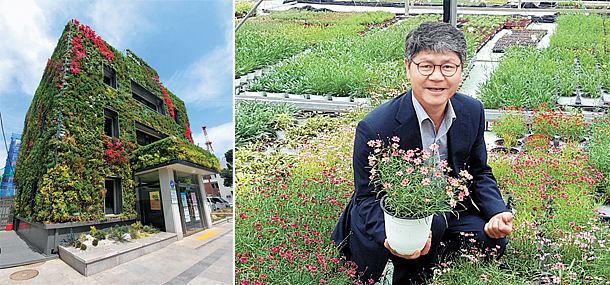Botanist creates bouquet of new Korean flower species

Right: Park Kong-young holds up a pot of Coreuri, a species developed from Coreopsis grandiflora, which originated in the United States. Left: The Gangdong District Office in eastern Seoul is covered with plants, one of Park’s ideas throughout the country to help raise awareness on wildflowers and plants. [URISEED GROUP]
“This is called Coreuri,” he said as he held up a wildflower bred from Coreopsis grandiflora. “I focused on breeding the species into a new type, so that the normally yellow flower could bloom in different colors, like orange, red, white and pink.”
Coreopsis grandiflora originated in the United States and was first imported to Korea in the 1960s.
“Coreopsis grandiflora can grow quite tall, up to 150 centimeters (59 inches), but the new species I developed grows up to 10 centimeters, so they can be cared for easily in flower pots or in the garden beds,” Park said. “The name Coreuri is a portmanteau of the flower’s original name, Korea and uri, which means ‘us’ in Korean.”
The name Coreopsis is from the Greek words koris and opsis, meaning “bedbug view,” because its small flat fruits resemble bedbugs.
Another example is the “Miss Kim lilac.” An American botanist took a Syringa patula and developed it into a garden species, and named it after a Korean coworker surnamed Kim. The lilac takes up 30 percent of the lilac market in the United States.
Though the origin of the species was in Korea, because an American botanist created it, Korea pays a royalty to import them.
Park’s Uriseed Group, based in Icheon, Gyeonggi, has developed 120 new species of flowers and sells 50 to Japan, European countries, the United States and Australia with royalty payments.
Park said he first got interested in wildflowers after he was stationed near the demilitarized zone during his military service in the 1980s, when he began to study the wildflowers blooming there.
He said he would dig up flowers to study their roots and find books on them. Once, he said, he almost died after he tried eating a flower that turned out to be poisonous.
“I’ve always dreamed of becoming a poet who writes about farmers and agriculture,” Park said. “That’s how much I was interested in plants and agriculture in general. After completing military service, I created a club for wildflower fanatics. I was just so into them.”
Park worked at a plant company upon graduating from college and established Uriseed Group in 2000.
His organization’s specialty is developing flowers that bloom for a long time.
“Most of the species developed by Uriseed are perennials,” he said, “blooming from spring to winter.”
Many of the wildflower species developed at Uriseed Group are popular for use in gardens abroad, Park said.
“In Japan or Europe, where the gardening culture is quite developed, it is not only important to select the right kinds of flowers, but also to choose ones that give off a certain vibe or feeling,” he said. “A lot of our wildflower species tend to be short and have small flowers, and so they are often picked to fill up a garden in the background.”
Park also spends his time promoting Korea’s wildflowers within the country, and has spearheaded projects to cover the walls near the entrance to the No. 1 Namsan Tunnel in central Seoul with wildflowers, and also to cover the building of Gangdong District Office in eastern Seoul with plants.
He also planted wildflowers at the Saengcho International Sculpture Park in Sancheong County, South Gyeongsang, which hosted a pink moss festival in April that attracted some 50,000 visitors. Sancheong is Park’s hometown.
“My goal is to develop wildflower species that can bloom all four seasons, like the flowers in the subtropical or Mediterranean regions,” Park said. “I want to share the beauty of wildflowers from Korea with the rest of the world.”
BY CHOI MO-RAN [chung.juhee@joongang.co.kr]










with the Korea JoongAng Daily
To write comments, please log in to one of the accounts.
Standards Board Policy (0/250자)